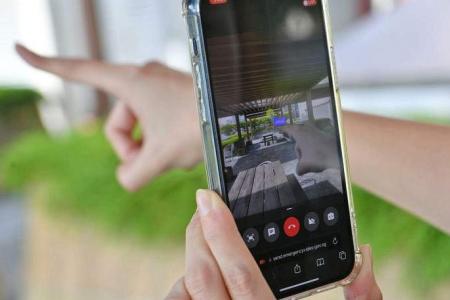Public can live-stream emergencies to police and SCDF using link to new video system
Those calling in 999 or 995 to report a fire or a murder may be able to provide operators a live stream of the situation from their mobile phones.
Depending on the situation, a link to the emergency video system will be sent via an SMS to the caller, who after clicking on it, will be able to use his phone camera to relay footage of what he is seeing.
The new system, which is used by both the police operations command centre and Singapore Civil Defence Force (SCDF) operations centre, was rolled out on Monday.
The authorities assured the public they would only be able to access their phone’s camera function and not other parts of the phone like files, apps or photo gallery.
The system was developed by the police, SCDF and Home Team Science and Technology Agency (HTX), in collaboration with ST Engineering.
It was first announced during the annual police workplan seminar in 2021, and was slated for roll-out in late 2023.
The agencies said that during emergency calls, officers at the operation centres may sometimes find it difficult to understand the situation. Especially those that are complex and dynamic, where the caller might not be able to give an accurate description of what is happening.
The new emergency video system will aid in situational assessment and in decision-making processes, they added.
A police spokesman said that before the link is sent to the caller, police and SCDF operators will assess if it is useful to initiate a live video stream. This will only be done once the operator knows it is safe for the caller to do so.
Once the caller agrees, the SMS with a hyperlink will be sent to him.
The caller can then click on it to activate the browser on his phone, without having to install other apps, which would allow the operator to view what the caller is filming.
The hyperlink, which can only be accessed once, will expire after a short while if the caller does not tap on it, said the police spokesman.
The spokesman added that the caller, who has to remain on the phone call during the live video stream, has to be on speaker phone or using an earpiece.
For the police, some examples of incidents when the link might be sent include fighting in public, a terrorist attack, or a random public assault.

The live-stream option may also be given to someone calling in a crime scene, like the aftermath of a murder or housebreaking.
Station Inspector Dian Masura Mohamed E Zarki, 41, is an officer who will be operating the system.
She said it will help her better respond to emergencies by allowing her to see the incident surroundings.
She said: “I would also be able to give the relevant information to my officers who are responding to the emergency. This allows us to respond more effectively.”
SCDF operators may also initiate the live video stream for fires, road traffic accidents or rescue incidents.
They may also do so for hazardous material and medical incidents where the caller is unable to describe a patient’s condition.
During major emergencies that involve the police and SCDF – like a big fire – the same live stream can be shared between the two operation centres.
For all scenarios, the police spokesman said both agencies expect to receive multiple calls and the operations centres may request to activate the emergency video system for some callers only.
Both police and SCDF operators may initiate the video stream for incidents when the caller is unable to give the exact location of an emergency, like along expressways or unfamiliar roads.
Colonel Dennis Quah, the commander of SCDF’s operations centre, said this will be useful for the centre in sending resources to the location promptly.
He said: “This is especially important in areas that are remote such as nature reserves, or even roads and expressways where members of the public may find difficulty in describing the location correctly.”
Location tracking will stop once the video session ends, said the police spokesman.
In January 2021, there was a huge public outcry over privacy concerns when it was revealed that the police could use TraceTogether data, which was for Covid-19 contact tracing purposes, for criminal investigations also.
A Bill restricting the use of personal contact tracing data in criminal investigations to only serious crimes, such as murder and terrorism, was passed in Parliament in February 2021 with assurances of safeguards to protect people’s data.
In response to queries from The Straits Times on whether the police can access other parts of the caller’s phone like files, browser history and photos once the link for the emergency video system is clicked on, the police spokesman said no.
She said: “The live video stream will use the web browser on the caller’s mobile phone, and apart from the phone’s location that will be sent together with the video stream, police will not have access to other apps or data stored in the caller’s mobile phone.
“The system does not allow control over the caller’s mobile phone.”
The spokesman added the videos will be stored and may be produced in court as evidence when necessary or upon request by the public prosecutor.
The footage will not be made accessible to members of the public, the spokesman added.
Get The New Paper on your phone with the free TNP app. Download from the Apple App Store or Google Play Store now



